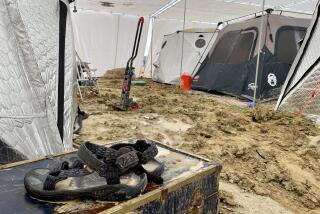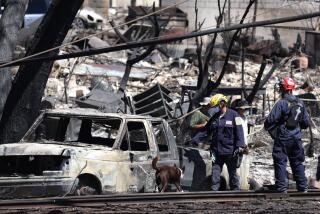Perseverance rover pays tribute to 2018 Camp fire victims
When NASA’s Perseverance rover landed on Mars this week, it brought along with it a tiny piece of Paradise.
The 2,260-pound rover, built at NASA’s Jet Propulsion Laboratory in La Cañada Flintridge, carried silicon chips inscribed with the names of nearly 11 million people from around the world, including the 85 who died in the 2018 Camp fire in and around Paradise, Calif.
Jerry Stoces, a former NASA employee, helped arrange the memorial for victims of the Camp fire, which was ignited by a faulty Pacific Gas & Electric transmission line.
“The NASA team was very touched by how many lives were affected by this fire,” Stoces told KRCR-TV Channel 7 in Redding. “We felt terrible for the lives lost and we wanted to do something special.”
Perseverance bore another tribute: a plaque depicting planet Earth above the rod of Asclepius, the international symbol from Greek mythology of healing and medicine, marking the COVID-19 pandemic’s toll and honoring healthcare workers and first responders. It is attached to the left side of the rover’s chassis.
The other 10,932,295 names etched on the rover’s microchips are from NASA’s “Send Your Name to Mars” campaign. The names, along with 155 essays written by schoolchildren who were finalists in a “Name the Rover” contest, were stenciled by electron beam onto three fingernail-sized chips and attached to the spacecraft.
Viewers around the world tuned in Thursday to watch the rover make its landing onto an ancient lakebed on the planet 293 million miles away. The rover’s harrowing descent and landing were described by NASA engineers as “seven minutes of terror” because they involved a dramatic deceleration and required a heat shield, a supersonic parachute and the deployment of roughly 21-foot-long tethers.
Perseverance used a sophisticated navigation system to autonomously sense its location over the Martian surface and maneuver accordingly during its descent, according to JPL.
On Mars, Perseverance strives to answer one of life’s big questions: Are we alone in the universe?
To that end, NASA strategically targeted Jezero Crater as its landing destination. Scientists think the crater is one of the most promising places to look for organic molecules and other signs of microbial life that might be preserved within layers of mud.
The rover will use a drill to take chalk-sized rock cores, collect rock and soil samples and store them until they can be sent back to Earth for analysis.
The rover will also use an onboard instrument suite to synthesize oxygen using the carbon dioxide in the thin Martian atmosphere. The proof-of-concept experiment could show that it’s possible on Mars to create both breathable oxygen and spacecraft fuel — two essential resources for any humans who may one day visit.
“The Mars 2020 Perseverance mission embodies our nation’s spirit of persevering even in the most challenging of situations, inspiring, and advancing science and exploration,” said acting NASA Administrator Steve Jurczyk, celebrating the agency’s most complex mission to Mars yet. “The mission itself personifies the human ideal of persevering toward the future and will help us prepare for human exploration of the red planet.”
Times staff writer Amina Khan contributed to this report.
More to Read
Sign up for Essential California
The most important California stories and recommendations in your inbox every morning.
You may occasionally receive promotional content from the Los Angeles Times.











